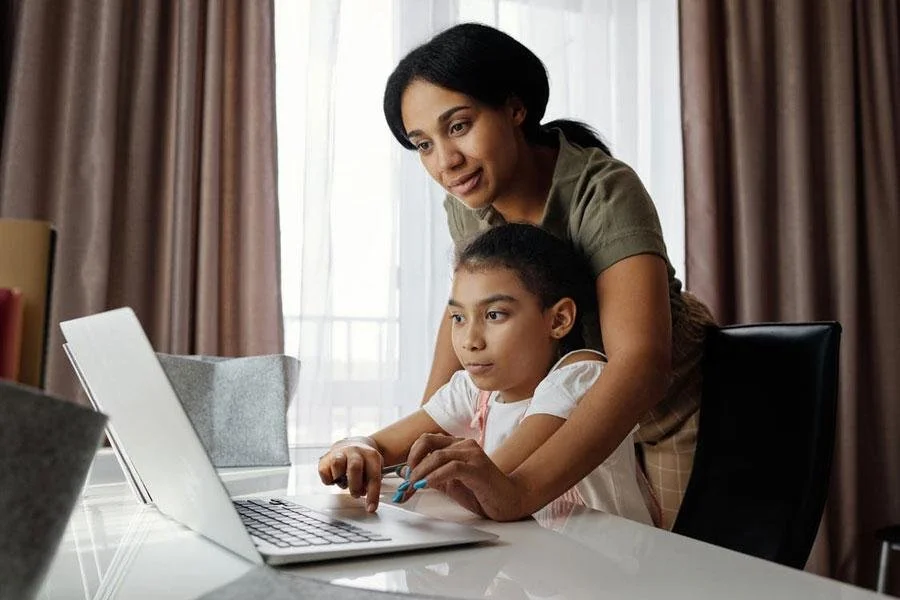Helping Children with Virtual Learning
Many children are continuing to do school from home due to the COVID-19 pandemic. Whether your students are online-only or hybrid learning (meaning some days are spent in school), there are many ways of helping children with virtual learning. Though distance learning isn’t new at this point, you can find new avenues to help your kids succeed.
Minimize distractions
Most children are familiar with devices, and some have their own phones, tablets, and computers. However, these devices are usually used for fun. Children should now learn that they will need to turn off their devices or put them in sleep mode while they are virtual learning. Other distractions can be reduced by designating a specific space for learning (see the next tip).
Some schools provide a laptop for their students. If possible, limit your children’s use of other devices while they are in school and only allow them to use their laptops. This encourages children to focus on their work and reduces distractions. This also leads us to our next point—creating a specific space for learning.
Designate a space for learning
Not everyone has the space, but if you do, consider creating a distinct home learning environment for your kids. Even a small space can work well. Kids will work best when they engage in virtual learning in a comfortable and quiet space devoted to school. This could be a space in their bedroom, the den, a large closet, a desk in the kitchen, or whatever works best for your family. Allow children to personalize space by decorating with their artwork. Make sure they have all the supplies they need close by, like computer chargers, pencils and pencil sharpeners, headphones, access to the printer if needed, and so on. This can encourage autonomy and independence in children. If you have room, make multiple learning spaces. Kids could benefit from having one space for zoom classes and a separate, more comfy space for reading time.
Establish a routine
When helping children with virtual learning, it’s essential to establish good habits and focus on time management. You can start with more structure and adjust as needed. Start by helping kids wake up, get dressed, and make their beds. Create time chunks that are predictable throughout the day. Increasing predictability can help regulate emotions, and routines can increase feelings of safety. Consider the number of structures kids has at school—most children will benefit greatly from a daily schedule. You can even model their day after their normal school day.
However, remember to be flexible. Talk to your children about how the routine is working, and change it to meet their (and your) needs. Schedule in free time as well. Research clearly demonstrates that free play and unstructured time benefit kids. Kids will benefit from knowing what to expect every day.
Communicate with educators and children
Stay in touch with teachers, school leaders, counselors, and your student about how learning is going. Teachers may take a day or two to respond, but continue to let them know if you have any concerns. Your student will benefit from clear expectations and rules that you communicate with them. Since you may be home together all day long, establish clear house rules that help you all work together, like “respect each other’s space.”
Kids also need communication and face-to-face interaction with teachers (even if it is virtual). This face-to-face contact helps teachers pick up on children’s body language that can communicate levels of understanding and confidence in learning.
Check-ins
Check-in with your student in the morning. Ask questions like: what subjects do you have today? Do you have any quizzes or tests? What can I do to help? Do you need any resources? During this check-in, you can create a to-do list of two or three specific items that need to get done that day. Check-in at the end of the day might include questions like: How much progress did you make today? What did you learn? What was difficult? How can we make tomorrow even better? Include plenty of positive feedback and encouragement during check-ins. Ask open-ended questions during this time to encourage children to talk about their emotions.
Take breaks
Build-in plenty of screen breaks and time for physical activity. Kids will be sitting in front of the computer for long stretches of time. This includes every age group and can be especially helpful for kids who have increased trouble concentrating. Go on walks, runs, play with the dog, stretch, do jumping jacks, or build an obstacle course in the yard. Whatever gets kids moving and away from a screen will help their brains and bodies. It’s important to know that physical activity and time spent outside to reduce stress levels and help increase readiness to learn.
Social supports
Much of what children learn at school involves learning social skills. Try to include social interaction and increase social support for your children when they are not physically attending school. Try doing schoolwork virtually with friends. Find an older student to tutor your student. One-on-one help is needed now more than ever as students have less contact with teachers. Your student could even try out a pen pal friendship.
Take care of yourself
Make sure you are attending to your own physical, emotional, mental, and spiritual needs. Taking even a few minutes a day for yourself can help you to have enough energy to support your kids while doing school online. Due to the pandemic, many children are doing school online. Helping children with virtual learning can be stressful, so practice self-care as much as possible.
Just like adults, children today are facing more change and stress due to the COVID-19 pandemic. If your child has special needs for virtual learning, check out the National Center for Learning Disabilities’ guide for parents. If you feel you or your child need emotional support during this time, please reach out to us. Our team of therapists is here to provide support and guidance. We look forward to connecting with you!






